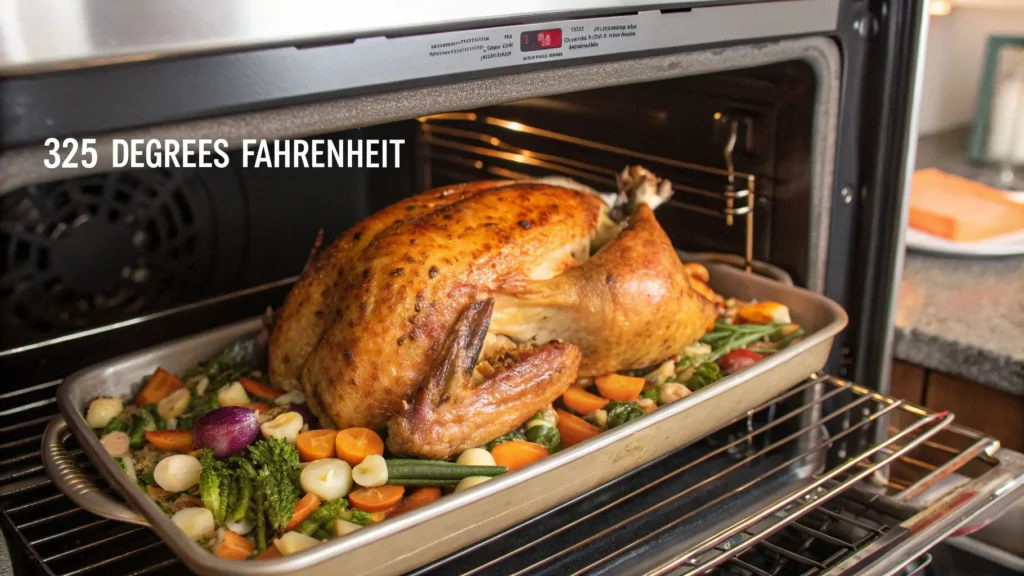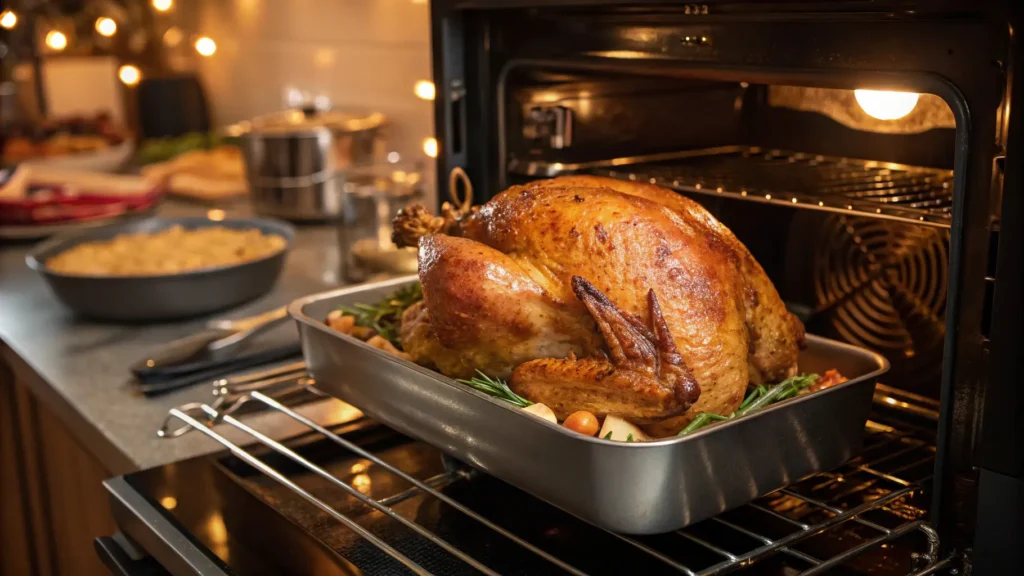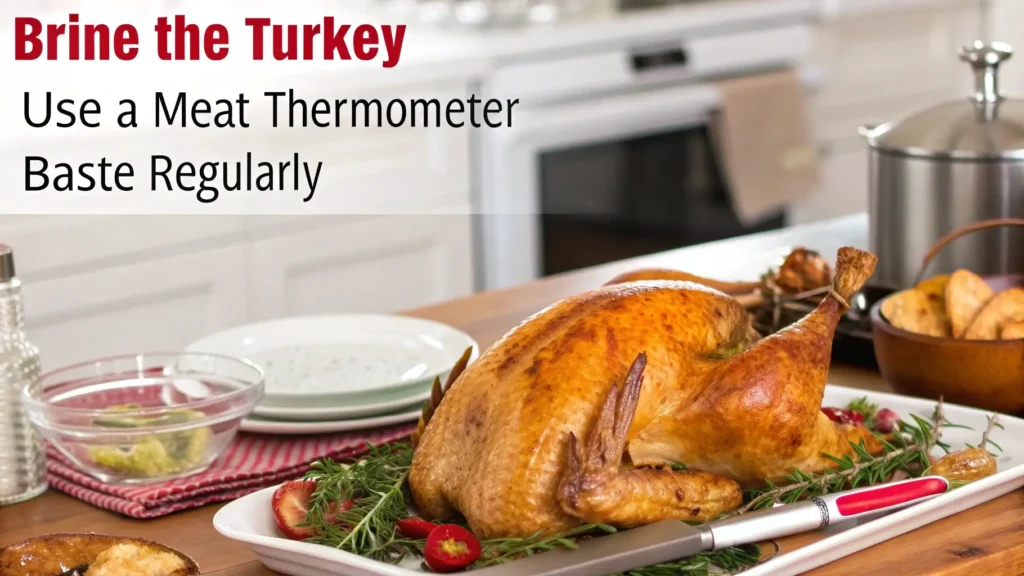When it comes to cooking the perfect turkey, one question sparks endless debate: Is it better to cook a turkey at 325 or 350? The answer isn’t just about numbers—it’s about science, taste, and tradition. In this article, we’ll explore the pros and cons of each cooking temperature, provide a head-to-head comparison, and offer expert tips for ensuring your turkey is juicy, flavorful, and beautifully golden. Whether you’re preparing a feast for Thanksgiving or a celebratory dinner, this guide will help you choose the best method for roasting your bird to perfection.

Introduction to Turkey Cooking Temperatures
Why Turkey Cooking Temperatures Matter
Cooking a turkey is both an art and a science. The temperature you choose can significantly affect the texture, moisture, and flavor of your turkey. Whether you’re aiming for crispy skin, moist meat, or both, the temperature sets the tone. For instance, low temperatures like 325°F cook the meat more slowly, while higher temperatures like 350°F are faster but may risk drying out certain parts of the bird.
Overview of Common Temperature Preferences
Most home cooks prefer roasting at either 325°F or 350°F, as these temperatures strike a balance between speed and results. While some recipes call for even higher settings to brown the skin, others recommend a low-and-slow approach for tender meat. Each method comes with its own merits and challenges, making it crucial to understand which temperature best fits your needs.
Debunking Myths About Low and Slow Cooking
There’s a common misconception that cooking a turkey “low and slow” guarantees the best results. But guess what? That’s not always the case. At excessively low temperatures, the meat can lose moisture, resulting in a dry, bland turkey. Similarly, cooking too fast at high temperatures risks uneven results—where the exterior burns while the interior remains undercooked. Striking a balance is key to achieving a beautifully roasted turkey.

Cooking Turkey at 325°F
The Science Behind 325°F: Benefits and Drawbacks
Cooking a turkey at 325°F is often seen as the “safe zone.” The lower temperature allows for even cooking, which helps prevent the dreaded dry breast meat. When heat spreads gently through the bird, the result is often tender, juicy turkey that’s hard to beat. However, this method takes longer, so it may not be ideal if you’re short on time.
On the downside, slower cooking means there’s a risk of overcooking certain parts if you don’t monitor closely. Additionally, while the meat stays moist, you might not achieve that perfectly crispy skin everyone craves.
Achieving Moist Meat at Lower Temperatures
If you’ve chosen 325°F, focus on preparation to lock in moisture. Start by seasoning the turkey generously, inside and out, and consider brining it beforehand. Brining not only enhances flavor but also helps the bird retain moisture throughout the long cooking process. Use a meat thermometer to track progress and avoid overcooking—165°F in the thickest part of the thigh is your golden number.
Another tip? Cover the turkey with foil during the initial cooking stages to trap steam and prevent the meat from drying out. Then, uncover it near the end to allow the skin to crisp up nicely.
How to Adjust Cooking Time Per Pound at 325°F
Cooking at 325°F requires a little patience. Expect to spend about 15–17 minutes per pound. For example, a 12-pound turkey will take roughly 3 to 3.5 hours. Adjust based on your oven’s efficiency and whether the bird is stuffed or unstuffed. Stuffed turkeys take longer, so plan accordingly to ensure the stuffing reaches 165°F internally.
When considering Is it better to cook a turkey at 325 or 350?, remember that 325°F emphasizes tenderness and moisture but requires careful timing and preparation.
Cooking Turkey at 350°F
The Advantages of 350°F for a Crispier Skin
If your goal is a beautifully golden, crispy turkey, 350°F is the sweet spot. This slightly higher temperature allows the skin to brown evenly while cooking the meat more quickly. For many cooks, the faster cooking time at 350°F is a big plus, especially when juggling side dishes and desserts.
That said, cooking at 350°F does come with risks. The higher heat can cause parts of the bird—like the breast meat—to dry out if you’re not vigilant. Using techniques like basting or starting with the turkey breast-side down can help combat this.
Balancing Speed and Flavor at Higher Temperatures
A turkey roasted at 350°F typically cooks in 13–15 minutes per pound, making it an efficient choice. This temperature strikes a balance between cooking quickly and ensuring the meat stays juicy. To enhance flavor, brush the bird with butter or olive oil before roasting, and consider stuffing the cavity with aromatic herbs and citrus.
But beware of overcooking! A meat thermometer is your best friend here, ensuring you pull the turkey out as soon as it reaches 165°F in the thickest part of the thigh.
Step-by-Step Guide to Cooking a Turkey at 350°F
- Preheat your oven to 350°F.
- Prep the turkey by patting it dry and seasoning generously.
- Place the bird on a roasting rack to allow even air circulation.
- Cover the breast with foil for the first hour to protect it from the higher heat.
- Remove the foil halfway through and baste the turkey every 30 minutes for added moisture.
- Use a meat thermometer to check for doneness, ensuring the thickest part of the thigh reaches 165°F.
When asking Is it better to cook a turkey at 325 or 350?, consider whether you value speed and crispy skin more than the slow tenderness of a lower temperature. At 350°F, you’ll likely get a crowd-pleasing, Instagram-worthy turkey that still retains a good amount of moisture.
Head-to-Head Comparison: 325°F vs. 350°F
Cooking Times: How They Differ
One of the most noticeable differences when choosing 325°F vs. 350°F is the cooking time. A lower temperature of 325°F demands patience, taking about 15–17 minutes per pound, while 350°F speeds things up to about 13–15 minutes per pound. For example, a 12-pound turkey will take approximately 3 to 3.5 hours at 325°F but only around 2.5 to 3 hours at 350°F.
While faster cooking at 350°F might seem more convenient, keep in mind that rushing the process can lead to uneven results. The breast meat may cook faster than the dark meat, increasing the risk of dryness.
Impact on Juiciness and Texture
Juiciness and texture are key to answering the question: Is it better to cook a turkey at 325 or 350? Lower temperatures help preserve the turkey’s natural juices, making 325°F a great option for tenderness. Conversely, the higher heat of 350°F can create a crispier skin but may lead to slightly drier breast meat if not carefully monitored.
Which Temperature Is Best for Different Sizes of Turkeys?
The size of your bird also plays a role in temperature selection. Larger turkeys often benefit from 325°F because the slower process ensures the heat reaches the center without overcooking the outer layers. Smaller turkeys, which cook faster, are well-suited for 350°F, as their compact size minimizes the risk of dryness.
Factors Influencing Temperature Choice: Ovens, Altitude, and Personal Preference
Your oven’s performance and external factors like altitude can also influence your choice. At higher altitudes, where air pressure is lower, cooking may take longer, making 350°F a better choice. Ultimately, personal preference—whether you value crispy skin or moist meat—will guide your decision.
For a delicious take on seasoning and preparing turkey, check out the Creole Butter Turkey Breast Recipe on TangleRecipes for ideas that pair well with both temperature methods.
Tips for Perfect Turkey Roasting Regardless of Temperature

Preparation: Defrosting and Seasoning Your Bird
No matter the temperature you choose, preparation is key. Start by properly defrosting your turkey in the refrigerator—allow one day for every four pounds. Pat it dry to ensure even browning, and season generously with a mix of salt, pepper, and your favorite herbs.
For an extra flavor boost, consider dry-brining or marinating the turkey overnight. Brining helps retain moisture, making it a great choice whether you’re cooking at 325°F or 350°F.
Using a Meat Thermometer for Precision
The secret to perfect turkey is using a meat thermometer. Place the probe in the thickest part of the thigh, avoiding bone, and aim for 165°F. This ensures your turkey is safe to eat while preventing overcooking.
Resting the Turkey Before Carving
After removing the turkey from the oven, resist the urge to carve immediately. Let it rest for at least 20–30 minutes. This resting period allows the juices to redistribute, giving you moist slices every time.
For more turkey-cooking tips, visit TangleRecipes’ helpful guide: Should I Rub Butter or Oil on My Turkey?.
FAQs Section
How Long Does It Take to Cook a Turkey at 325°F vs. 350°F?
The time it takes to cook a turkey depends largely on the temperature you choose. At 325°F, plan for about 15–17 minutes per pound, which means a 12-pound turkey will need 3 to 3.5 hours. In contrast, 350°F reduces cooking time to about 13–15 minutes per pound, requiring just 2.5 to 3 hours for the same bird. Deciding Is it better to cook a turkey at 325 or 350? ultimately hinges on whether you value slower, even cooking or a slightly faster preparation time.
Does Cooking a Turkey at 350°F Dry It Out?
Not necessarily, but higher temperatures like 350°F can dry out the breast meat if left unattended. To avoid this, cover the breast with foil during the first half of cooking, and baste the turkey every 30 minutes to lock in moisture.
Can You Start Cooking at 350°F and Reduce to 325°F?
Absolutely! This hybrid approach lets you enjoy the best of both worlds. Starting at 350°F crisps up the skin, while reducing to 325°F ensures tender, juicy meat. Monitor with a meat thermometer to ensure optimal results.
For additional tips on managing turkey texture, check out TangleRecipes’ guide: What Makes Turkey Breast Tough?.
Conclusion: Finding the Best Temperature for Your Turkey
Summarizing Key Points About 325°F and 350°F
Choosing Is it better to cook a turkey at 325 or 350? boils down to your priorities. If you want tender meat and don’t mind a longer cooking time, 325°F is your go-to. On the other hand, if you’re pressed for time or aiming for a crispier skin, 350°F may be the better choice.
Recommendations Based on Turkey Size and Desired Texture
Smaller turkeys (under 12 pounds) are ideal for 350°F, as they cook faster and stay juicy. Larger birds benefit from 325°F, which ensures even cooking without sacrificing moisture. Regardless of your chosen temperature, use a meat thermometer to avoid overcooking, and always allow your turkey to rest before carving.
Ready to enhance your turkey-cooking game? Explore flavorful marinades and seasoning ideas on TangleRecipes, like the savory Creole Butter Turkey Breast Recipe. These tips, combined with your perfect temperature choice, will make your next turkey a feast to remember!

